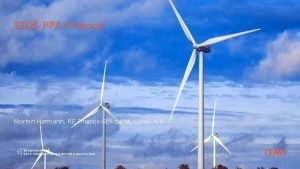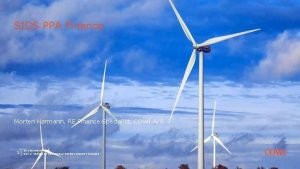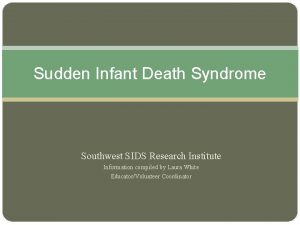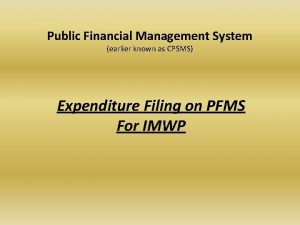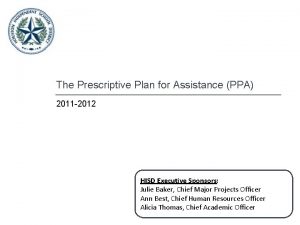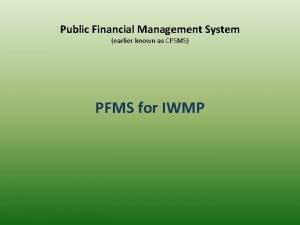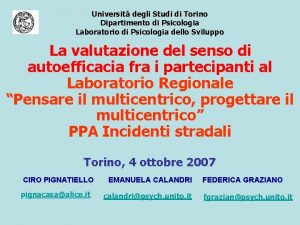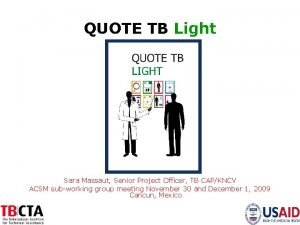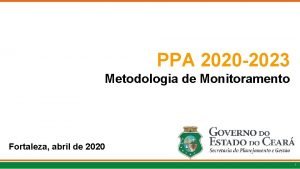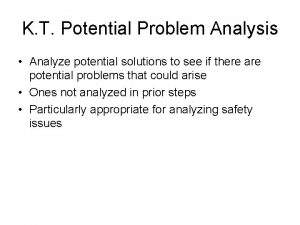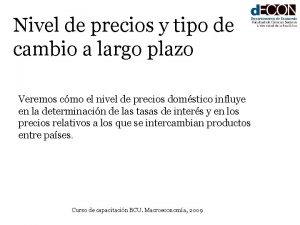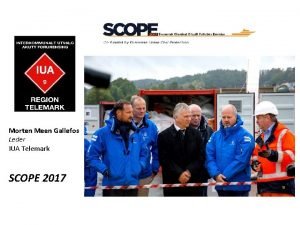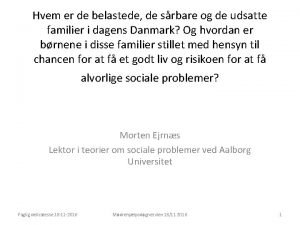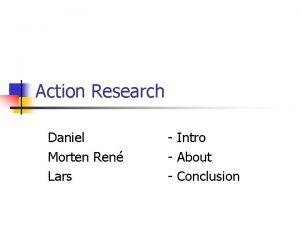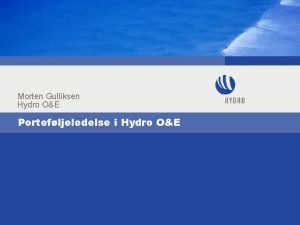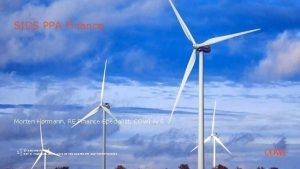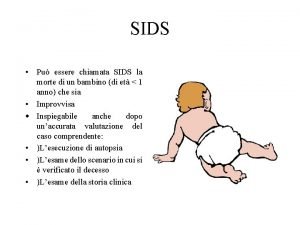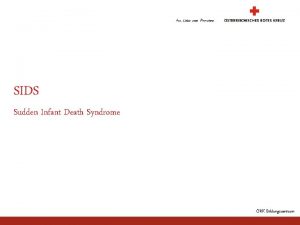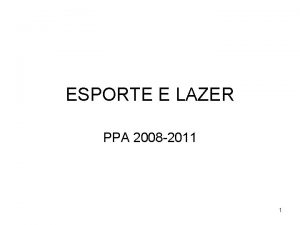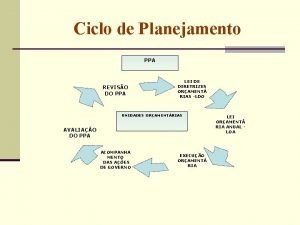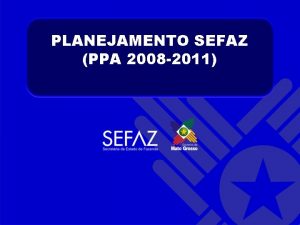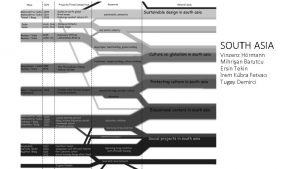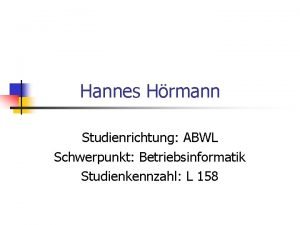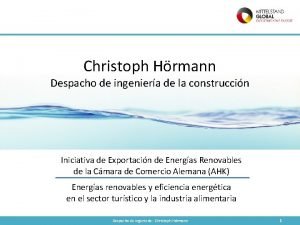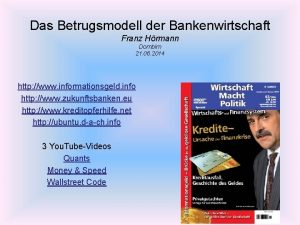SIDS PPA Finance Morten Hrmann RE Finance Specialist




































- Slides: 36

SIDS PPA Finance Morten Hørmann, RE Finance Specialist, COWI A/S 1 26 NOVEMBER 2019 DAY 1: BASICS OF RENEWABLE ENERGY PROJECT FINANCE

Who are we? 2 Morten Hørmann Gabriel Zeitouni Rasmus Dilling • COWI • Economist • Specialized in renewable energy modelling • COWI • Engineer • Specialized in renewable energy project development • COWI • Legal expert • Specialized in procurement of renewable energy 26 NOVEMBER 2019 DAY 1: BASICS OF RENEWABLE ENERGY PROJECT FINANCE Anita Jurgens • COWI • Economist • Specialized in financial analysis and costing of renewable energy

Contractual design in PPA Stakeholders and PPA structure Impacts of PPA design Financial analysis 3 26 NOVEMBER 2019 DAY 1: BASICS OF RENEWABLE ENERGY PROJECT FINANCE Complexity Course concept

Keep it simple › Making things complex and difficult is easy › Simplifying and streamlining is very difficult › But the rewards for simplifying are that much greater › Learning 4 26 NOVEMBER 2019 DAY 1: BASICS OF RENEWABLE ENERGY PROJECT FINANCE

Focus on the PPA › Agreement between producer and offtaker of electricity on the price, quality, quantity etc. . of electricity › Ensures stability, confidence and transparency › Necessary for long term loan financing › Draws in private equity 5 26 NOVEMBER 2019 DAY 1: BASICS OF RENEWABLE ENERGY PROJECT FINANCE › Ensures the offtaker receives what it is paying for › Without a PPA? No private equity, no financing.

Course overview 6 Day 1 Day 2 Basics of renewable energy finance Basic exercises on RE project finance 26 NOVEMBER 2019 DAY 1: BASICS OF RENEWABLE ENERGY PROJECT FINANCE Day 3 Day 4 Financial modelling of PPA contracts Stakeholders Complex negotiations for finalizing PPAs Exercises on PPA modelling Roleplaying exercises on PPA bidding Exercises on project size and currency risk

DAY 1 Basics of Renewable Energy Finance › How Renewable Energy projects are financed › Basics of cash flow modelling and importance of financial indicators 7 26 NOVEMBER 2019 DAY 1: BASICS OF RENEWABLE ENERGY PROJECT FINANCE › Basic exercises on RE project finance i. e. not in consideration of PPA contract aspects yet

Financing Renewable Energy 8 26 NOVEMBER 2019 DAY 1: BASICS OF RENEWABLE ENERGY PROJECT FINANCE

Project financing vs corporate/balance financing › Renewable energy projects are very often structured around a “Special Purpose Vehicle” › Owns and operates the RE assets › Is a separate unit › Loans taken by the SPV have no recourse outside the SPV › only security is the assets and the revenue stream from those assets › This is project financing 9 26 NOVEMBER 2019 DAY 1: BASICS OF RENEWABLE ENERGY PROJECT FINANCE › Firms may use loan financing to invest in new or replacement capacity › Loans have recourse in the Firm’s total balance sheet rather than just the asset › Perceived as less risky by lending institutions › This is corporate financing

Public private partnerships 10 26 NOVEMBER 2019 DAY 1: BASICS OF RENEWABLE ENERGY PROJECT FINANCE

Project cost components Non-exhaustive list CAPEX • Generators • Civil works • Electrical infrastructure • Management OPEX • Operations: e. g. salaries of staff and lease • Maintenance: Scheduled and Non Scheduled Penalties • Delays • Over/under production Financial transaction costs • Cost of capital: Interest on loans, return on equity • Cash reserves • Exchange rate risk Taxes • Corporate income taxes • VAT, duties, energy taxes 11 26 NOVEMBER 2019 DAY 1: BASICS OF RENEWABLE ENERGY PROJECT FINANCE

Project revenues Energy • Primary output • Satisfies demand • Crowd out fossil fuels Capacity • System services, e. g. balancing, reserve capacity, frequency response, inertia 12 26 NOVEMBER 2019 DAY 1: BASICS OF RENEWABLE ENERGY PROJECT FINANCE PPA tariff • Main parameter of the PPA contract • Guarantee of cash flow for debt service Curtailment compensation • Important for variable renewable energy Capacity remuneration • Replacing thermal generation can be difficult due to the loss of system services

Basics of project financial analysis 13 26 NOVEMBER 2019 DAY 1: BASICS OF RENEWABLE ENERGY PROJECT FINANCE

Cash flow modelling › The cash flow waterfall is one of the most important elements in project finance › Allocates available cash to different recipients by seniority/priority › Vital in demonstrating that the cash flow generated by the project is enough to cover all liabilities › In order from top to bottom is: › › › › 14 Interest income Tax Maintenance CAPEX Senior and junior debt service Movements in the debt reserve account DSRA Cash sweep Returns to equity. 26 NOVEMBER 2019 DAY 1: BASICS OF RENEWABLE ENERGY PROJECT FINANCE

Funding › Loans are the primary source of financing for RE projects › Senior loans are long term and the first in line to be repaid from available cash. › Securities in the physical assets › Junior loans with no security in physical assets are sometimes required › Significantly higher interest rate › Are only repaid after senior loans have been served. 15 26 NOVEMBER 2019 DAY 1: BASICS OF RENEWABLE ENERGY PROJECT FINANCE › Special purpose loans during construction are also common › High interest rate › Very little security in physical assets › Converted into senior and junior loans at the commencement of operations › Duration of the loans (the tenor) does not need to equal the technical life of the project › Loan tenors shorter than the project life are common › The loan tenor will very likely be shorter than the duration of the PPA contract

WACC 16 26 NOVEMBER 2019 DAY 1: BASICS OF RENEWABLE ENERGY PROJECT FINANCE 14. 0% Commercial operation Equity 12. 0% 10. 0% 8. 0% PPA contract Loan + equity 6. 0% Construction › The Weighted Average Cost of Capital (WACC) is a measure of the average cost of employing the capital needed for the project › The WACC simply weighs the interest rate of each source of capital by the sources’ share of total CAPEX › Differences in loan tenor, PPA contract duration and technical life can complicate the concept of WACC › The WACC is a key concept used in several financial indicators such as NPV and LCOE and to asses IRR. 4. 0% 2. 0% 0. 0% 19 021 023 025 027 029 031 033 035 037 039 041 043 045 2 2 2 20

NPV 2019 › The Net Present Value (NPV) of a project is the simplest indicator of a financially sound project › Positive NPV means the return on investment will be higher than expected › NPV discounts all costs and revenues from the project to present value by using the WACC as discount rate › Allows comparison of CAPEX today with a revenue stream in the future 17 26 NOVEMBER 2019 DAY 1: BASICS OF RENEWABLE ENERGY PROJECT FINANCE 2020 $100*(1+i) $100/(1+i) $100

LCOE › The Levelized Cost of Electricity › Main indicator for comparison of economic performance of different energy projects › LCOE compares: › Discounted value of all project costs › Discounted value of the electricity generated by the project › LCOE is the average cost of one unit of electricity over the lifetime of the project 18 26 NOVEMBER 2019 DAY 1: BASICS OF RENEWABLE ENERGY PROJECT FINANCE › LCOE does not take into consideration: › Changes to cash flow › Risks › Incentives

IRR › Internal Rate of Return › A measure of the discount factor needed to make the NPV equal to zero › Can be compared to the WACC for a quick assessment of the financial feasibility of the project › IRR higher than the WACC indicates that the project will yield a higher return on investment than expected › At times, this value is also referred to as the Project IRR. 19 26 NOVEMBER 2019 DAY 1: BASICS OF RENEWABLE ENERGY PROJECT FINANCE NPV = 0

DSCR/DSRA › Debt Service Coverage Ratio › An indicator of the ability of the project to serve its debt › Calculated as the cash available for debt service divided by the debt service obligations › Calculated for each period in the financial analysis › DSCR values above 1 indicate that the project is able to serve its debt in that period › Minimum DSCR over the entire project lifetime should never fall below 1, and financial institutions may require a minimum DSCR that is much higher. 20 26 NOVEMBER 2019 DAY 1: BASICS OF RENEWABLE ENERGY PROJECT FINANCE › Debt Service Reserve Account › A cash reserve account › Targeted at providing additional cash in periods where the DSCR would otherwise fall below the minimum DSCR target › In periods with excess cash the DSRA can be filled up again › The DSRA is particularly useful in projects with high variability in revenues, e. g. variability in RE generation due to seasonality.

Depreciation › Depreciation is the gradual decline in the value of physical assets as they are worn down › Depreciation is an accounting measure › It does not have to replicate the exact value of the physical assets › Depreciation is often based on rules rather than actual value › Three common ways to estimate depreciation are: › Straight line › Decreasing value › Digit sum 21 26 NOVEMBER 2019 DAY 1: BASICS OF RENEWABLE ENERGY PROJECT FINANCE

Taxes › Corporate income tax is typically a percentage of earnings after interest on debt has been paid › Depreciation can have a big impact on tax payments › VAT and import duties › Relevant especially when project components are imported › Public funding of RE projects is sometimes achieved via tax credits › Partially lifts the tax burden from RE projects 22 26 NOVEMBER 2019 DAY 1: BASICS OF RENEWABLE ENERGY PROJECT FINANCE

Currency › Many RE projects are funded by International Financial Institutions (IFIs) › Loans are provided in an international currency › Loans are paid back in international currency › Revenues and operational costs are often generated in the local currency 23 26 NOVEMBER 2019 DAY 1: BASICS OF RENEWABLE ENERGY PROJECT FINANCE › Developments in the exchange rate can severely impact debt service › DSCR needs to be evaluated under worst case assumptions on the development in exchange rate

24 26 NOVEMBER 2019 DAY 1: BASICS OF RENEWABLE ENERGY PROJECT FINANCE

Guided tour of the model 25 26 NOVEMBER 2019 DAY 1: BASICS OF RENEWABLE ENERGY PROJECT FINANCE

26 26 NOVEMBER 2019 DAY 1: BASICS OF RENEWABLE ENERGY PROJECT FINANCE

Exercises Day 1 27 26 NOVEMBER 2019 DAY 1: BASICS OF RENEWABLE ENERGY PROJECT FINANCE

Getting used to the model › Always work in a copy › That way you can just open a fresh version if something goes wrong › Open the model › Navigate to introduction › Familiarize yourself with the colour codes › Navigate to the User Interface › Adjust the size of the results pane › Play around for a while › Don’t be afraid to mess up. You opened a copy – right? 28 26 NOVEMBER 2019 DAY 1: BASICS OF RENEWABLE ENERGY PROJECT FINANCE

Setting the stage › Choose Technology and uncertainty › Set Nominal capacity › Set first year of construction and construction time › Set technical life › Try changing uncertainty level and technology › What happens to the results? 29 26 NOVEMBER 2019 DAY 1: BASICS OF RENEWABLE ENERGY PROJECT FINANCE

Input data › Add a new CAPEX element › Use CAPEX 2 – rename to something relevant (e. g. your name) › Return to the User Interface › Include the new CAPEX element in the analysis › Do the same with OPEX › Choose either fixed or variable OPEX 30 26 NOVEMBER 2019 DAY 1: BASICS OF RENEWABLE ENERGY PROJECT FINANCE

Financing › Set up a financing structure › A mix of equity, senior and junior loans › Investigate how loan tenure and interest rates affect project KPIs › Input corporate tax rate › Investigate how exchange rate uncertainty impacts project KPIs › Is the minimum senior DSCR lower than 1? › Include loan financing of a DSRA 31 26 NOVEMBER 2019 DAY 1: BASICS OF RENEWABLE ENERGY PROJECT FINANCE

Feasibility › What is the internal rate of return (IRR) of your project? › What can you do to improve it? › Lower CAPEX? › Lower OPEX? › Lower uncertainty on energy production? › Higher PPA tariff? › What makes the most sense? › How does a higher IRR affect the DSCR? 32 26 NOVEMBER 2019 DAY 1: BASICS OF RENEWABLE ENERGY PROJECT FINANCE

Sensitivity analysis using the model 33 26 NOVEMBER 2019 DAY 1: BASICS OF RENEWABLE ENERGY PROJECT FINANCE

Running sensitivities 34 26 NOVEMBER 2019 DAY 1: BASICS OF RENEWABLE ENERGY PROJECT FINANCE

Tornado plot › Predefined functionality › Classic tornado plot › x% variation in inputs leads to ? % increase/decrease in project NPV › Indicates which parameters have the biggest impact on the results › Press the update button › Change the percentage change › Try pressing the button again 35 26 NOVEMBER 2019 DAY 1: BASICS OF RENEWABLE ENERGY PROJECT FINANCE

Tariff sensitivity › Changes inputs › CAPEX › AEP › Re-estimates the PPA tariff › Shows how sensitive the expeted PPA tariff is to variations in CAPEX and AEP › Define which sensitivity runs to run › Start at 49 › end at 96 › Run sensitivities 36 26 NOVEMBER 2019 DAY 1: BASICS OF RENEWABLE ENERGY PROJECT FINANCE
 Hrmann
Hrmann Hrmann
Hrmann Triple risk model sids
Triple risk model sids Triple risk model sids
Triple risk model sids Sids mid atlantic
Sids mid atlantic Triple risk model sids
Triple risk model sids Public financial management system was earlier known as
Public financial management system was earlier known as Ppa 7721
Ppa 7721 Ppa holidays
Ppa holidays Ppa 2011
Ppa 2011 Ppa orlando
Ppa orlando Pfms earlier known as
Pfms earlier known as Dipartimento psicologia torino
Dipartimento psicologia torino Ppa 3
Ppa 3 Ppa scoring for tb
Ppa scoring for tb Ppa ppap
Ppa ppap Ppa aucouturier
Ppa aucouturier Peran unit ppa
Peran unit ppa Ppa fortaleza
Ppa fortaleza Potential problem analysis example
Potential problem analysis example Ppa
Ppa Cbs dtu
Cbs dtu Morten ellegaard hell
Morten ellegaard hell Morten freundlich
Morten freundlich Morten rasch
Morten rasch Morten kargo
Morten kargo Morten meen gallefos
Morten meen gallefos Hva er strategiske markedsutfordringer
Hva er strategiske markedsutfordringer Kahoot makes learning awesome
Kahoot makes learning awesome Morten nielsen fab
Morten nielsen fab Morten bierganns
Morten bierganns Morten johannes lauridsen
Morten johannes lauridsen Morten stenak
Morten stenak Morten ejrnæs chanceulighed og risikofaktorer
Morten ejrnæs chanceulighed og risikofaktorer Samordnet kommunikasjon
Samordnet kommunikasjon Lars intro
Lars intro Morten gulliksen
Morten gulliksen
